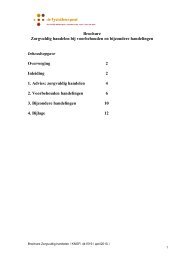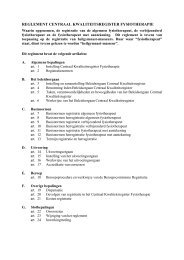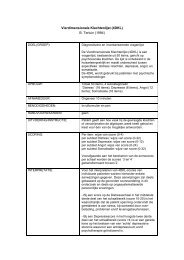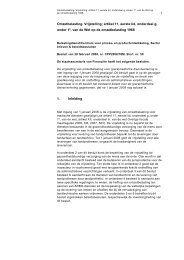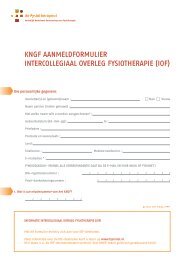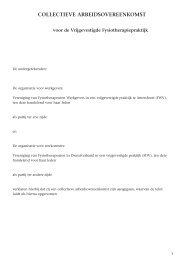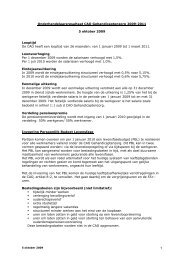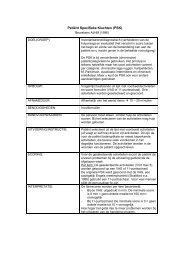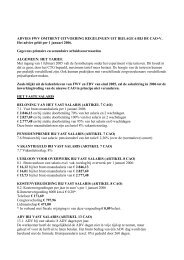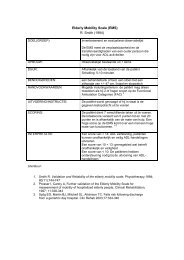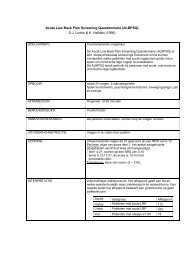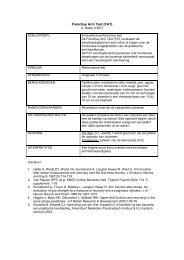Acupuncture and dry-needling for low back pain (Review)
Acupuncture and dry-needling for low back pain (Review)
Acupuncture and dry-needling for low back pain (Review)
You also want an ePaper? Increase the reach of your titles
YUMPU automatically turns print PDFs into web optimized ePapers that Google loves.
Although the conclusions showed some positive results of<br />
acupuncture, the magnitude of the effects were generally small.<br />
The average <strong>pain</strong> reduction (measured by continuous scales such<br />
as the VAS) in the group that received acupuncture <strong>for</strong> chronic<br />
<strong>low</strong>-<strong>back</strong> <strong>pain</strong> was 32% compared to 23% in those who received<br />
sham therapies <strong>and</strong> 6% in those who received no treatment. Furthermore,<br />
the terms used to express the strength of the evidence<br />
(strong, moderate <strong>and</strong> limited), as is st<strong>and</strong>ard in many systematic<br />
reviews, might be misinterpreted. These are relative terms <strong>and</strong> are<br />
often used to apply to a small number of “higher” quality studies.<br />
This may give the false impression that “strong” evidence means<br />
“definite” evidence, but this may not be the case.<br />
Although ef<strong>for</strong>ts were made to find all published RCTs, some relevant<br />
trials might have been missed. Twenty of the 35 included<br />
RCTs were published in English, seven in Japanese, five in Chinese<br />
<strong>and</strong> one each in Norwegian, Polish <strong>and</strong> German. Although no<br />
languages were excluded, the number of non-English journals indexed<br />
in electronic databases such as MEDLINE <strong>and</strong> EMBASE is<br />
limited. If additional trials are found, this review will be updated.<br />
The methodologic quality of the included RCTs, although improving<br />
over the past several years, was poor. There were two studies<br />
with fatal flaws, <strong>and</strong> 14 studies with higher <strong>and</strong> 19 studies with<br />
<strong>low</strong>er methodological quality. The methodologic quality in the<br />
current review was defined by the internal validity criteria, which<br />
referred to characteristics of the study that might be related to<br />
selection, per<strong>for</strong>mance, attrition, <strong>and</strong> detection bias. It seems reasonable<br />
that in the authors’ qualitative synthesis, the best evidence<br />
would be provided by the higher quality studies, which are less<br />
likely to have biased results. Although the levels of evidence in this<br />
review may be considered arbitrary, it seems unlikely that a different<br />
rating system would have resulted in different conclusions.<br />
The included studies were very heterogeneous in terms of population<br />
included, type of acupuncture administered, control groups,<br />
outcome measures, timing of fol<strong>low</strong>-up, <strong>and</strong> presentation of data.<br />
There<strong>for</strong>e, very few meaningful meta-analyses could be per<strong>for</strong>med<br />
<strong>and</strong> it was difficult to reach conclusions <strong>for</strong> most types of treatments.<br />
The experience <strong>and</strong> training of the acupuncturists who gave the<br />
treatments were mentioned in a few studies. Some studies used<br />
a protocol of a fixed set of points <strong>for</strong> all patients while others<br />
used a flexible protocol where the points were selected <strong>for</strong> each<br />
individual. Both methods are considered to be valid <strong>and</strong> were<br />
analysed together in this systematic review.<br />
No serious adverse events were reported in the trials included in<br />
this review. The incidence of minor adverse events was 5% in the<br />
patients submitted to acupuncture. In the literature, most of the<br />
reports of serious adverse events related to acupuncture are described<br />
as case reports. In the past years, various prospective studies<br />
were conducted, enabling the estimation of the true incidence<br />
of minor <strong>and</strong> major adverse events.<br />
Melchart <strong>and</strong> colleagues reported the biggest prospective study,<br />
covering over 760,000 treatments delivered by 7,050 German<br />
physicians over a 10-month period. They observed 6,936 minor<br />
(incidence of 91 per 10,000 treatments) <strong>and</strong> five major adverse<br />
reactions (6 per 1,000,000 treatments), which included: exacerbation<br />
of depression (one case), acute hypertensive crisis (one case),<br />
vasovagal reaction (one case), asthma attack with hypertension<br />
<strong>and</strong> angina (one case) <strong>and</strong> two cases of pneumothorax (Melchart<br />
2004).<br />
The other prospective studies did not observe any major adverse<br />
reactions. Yamashita <strong>and</strong> colleagues observed 65,482 treatments<br />
delivered by 84 therapists over a six-year period in Japan. There<br />
were 94 cases of minor adverse events, with an incidence of 14<br />
per 10,000 treatments, but this incidence was estimated using<br />
data from spontaneous reports of adverse event by the practitioner<br />
(Yamashita 1999). In another similar study by Yamashita<br />
<strong>and</strong> colleagues, they <strong>for</strong>ced practitioners to detect <strong>and</strong> report every<br />
acupuncture session, whether there were adverse reactions or not.<br />
Then, different incident rates of adverse reaction were obtained. A<br />
total of 391 patients were treated in 1,441 sessions, involving a total<br />
of 30,338 needle insertions. The incidence of recorded systemic<br />
reactions in individual patients was: tiredness (8.2%); drowsiness<br />
(2.8%); aggravation of pre-existing symptoms (2.8%); itching in<br />
the punctured regions (1.0%); dizziness or vertigo (0.8%); feeling<br />
of faintness or nausea during treatment (0.8%); headache (0.5%);<br />
<strong>and</strong> chest <strong>pain</strong> (0.3%) (Yamashita 2000).<br />
MacPherson <strong>and</strong> colleagues observed 34,407 treatments delivered<br />
by 574 Traditional Chinese Acupuncturists in the UK, over a fourweek<br />
period. There were 43 minor adverse events (incidence of<br />
12.5 per 10,000 treatments) (MacPherson 2001). White <strong>and</strong> colleagues<br />
observed 31,822 treatments delivered by 78 acupuncturists<br />
(physicians <strong>and</strong> physiotherapists) in the UK, over a 21-month<br />
period. There were 43 minor adverse reactions (incidence of 13.5<br />
per 10,000 treatments) (White 2001). Odsberg <strong>and</strong> colleagues observed<br />
9,277 treatments delivered by 187 physiotherapists in Sweden<br />
over a four-week period, <strong>and</strong> recorded 2,108 minor adverse<br />
reactions (incidence of 2,272 per 10,000 treatments) (Odsberg<br />
2001). Ernst <strong>and</strong> colleagues observed 3,535 treatments delivered<br />
by 29 acupuncturists in Germany over a 13-month period, <strong>and</strong><br />
recorded 402 minor adverse reactions (incidence of 1,100 per<br />
10,000 treatments) (Ernst 2003).<br />
The great variation in incidence of minor adverse events is probably<br />
due to different definitions of adverse reaction, research designs,<br />
or styles of acupuncture in the various studies.<br />
Because serious adverse events are rare, they continue to be reported<br />
in the <strong>for</strong>m of case reports. Recently published systematic<br />
reviews of case reports showed that these serious complications<br />
may include infections (human immunodeficiency virus, hepatitis,<br />
bacterial endocarditis) caused by non sterile needles, <strong>and</strong> fatal<br />
tissue trauma (pneumothorax, cardiac tamponade, spinal cord in-<br />
<strong>Acupuncture</strong> <strong>and</strong> <strong>dry</strong>-<strong>needling</strong> <strong>for</strong> <strong>low</strong> <strong>back</strong> <strong>pain</strong> (<strong>Review</strong>)<br />
Copyright © 2011 The Cochrane Collaboration. Published by John Wiley & Sons, Ltd.<br />
13



